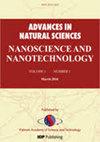Enhancing photoluminescence performance and pH photostability of nitrogen-doped graphene quantum dots via surface-passivated by polyethylene glycol
IF 2.1
Q3 MATERIALS SCIENCE, MULTIDISCIPLINARY
Advances in Natural Sciences: Nanoscience and Nanotechnology
Pub Date : 2023-11-15
DOI:10.1088/2043-6262/ad09c4
引用次数: 0
Abstract
The photoluminescence (PL) properties of nitrogen-doped graphene quantum dots (NGQDs) are highly dependent on reaction parameters. In this study, we developed new and fast protocols to surface passivate NGQDs with polyethylene glycol (PEG) using microwave irradiation. The resulting NGQDs-PEG exhibited highly stable PL with an emission peak at 424 nm when excited at 325 nm. The PL intensity of NGQDs with PEG increased with the volume of capping agents due to the enhancing luminescence effect of the surface functional group of polyethylene glycol. The optimal PEG amount of 2 wt% was found to improve the PL effect of NGQDs. Interestingly, the surface passivation of NGQDs with PEG enabled the NGQDs to exhibit strong PL performance across varying pH environments (from acidic to alkaline), addressing the issue of quenching of quantum dots in biological environments. Our research also focused on the ultrafast synthesis of NGQDs, where process parameters such as power value, catalyst volume, and reaction time were identified as important factors affecting NGQD luminescence. Our results showed that the optimal microwave power was 640 W, lower than that used in previous synthesis methods. Increasing the volume of catalyst promoted faster NGQD formation. The optimal reaction time was found to be 5 min, catalyst volume of 5 ml resulted in the highest PL intensity of NGQDs.通过聚乙二醇表面钝化提高氮掺杂石墨烯量子点的光致发光性能和 pH 光稳定性
掺氮石墨烯量子点(NGQDs)的光致发光(PL)特性高度依赖于反应参数。在本研究中,我们开发出了利用微波辐照使 NGQDs 与聚乙二醇(PEG)表面钝化的新型快速方案。得到的 NGQDs-PEG 具有高度稳定的聚光性能,在 325 纳米波长下激发时,发射峰在 424 纳米波长处。由于聚乙二醇表面官能团的增强发光效应,NGQDs 与 PEG 的聚光强度随着封端剂用量的增加而增加。研究发现,2 wt% 的最佳 PEG 用量可改善 NGQDs 的聚光效果。有趣的是,用 PEG 对 NGQDs 进行表面钝化后,NGQDs 在不同的 pH 值环境(从酸性到碱性)下都能表现出很强的聚光性能,从而解决了量子点在生物环境中的淬灭问题。我们的研究还侧重于 NGQDs 的超快合成,发现功率值、催化剂体积和反应时间等工艺参数是影响 NGQD 发光的重要因素。我们的研究结果表明,最佳微波功率为 640 W,低于以往合成方法所使用的功率。催化剂体积的增加促进了 NGQD 的快速形成。最佳反应时间为 5 分钟,催化剂体积为 5 毫升时,NGQD 的聚光强度最高。
本文章由计算机程序翻译,如有差异,请以英文原文为准。
求助全文
约1分钟内获得全文
求助全文
来源期刊

Advances in Natural Sciences: Nanoscience and Nanotechnology
NANOSCIENCE & NANOTECHNOLOGYMATERIALS SCIE-MATERIALS SCIENCE, MULTIDISCIPLINARY
自引率
4.80%
发文量
0
 求助内容:
求助内容: 应助结果提醒方式:
应助结果提醒方式:


